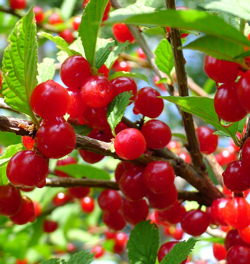Nanking Cherry Jelly & Leather

When your Nanking Cherry bushes produce an abundant crop of vibrant red fruits in early July through early August, it is worth knowing a few different ways they can be processed, as figuring out how to use all these tart and juicy cherries can be a challenge. The bushes are such big producers that it would be difficult to eat them all fresh unless you were feeding a small camp. I tried pitting them with my cherry pitter with the idea of drying them, but I had to adapt it to their smaller size and the return on the investment of my time wasn’t worth it. The pits are too big relative to the size of the fruits to pit them one at a time.
So instead I decided to try my hand at Nanking Cherry jelly. I tried two different recipes that produced quite different results. The jelly was delicious, but I was left with a lot of pulp. Seemed like the perfect thing to make into fruit leather. Turned out to be even better than the jelly. Here is what I did:
Nanking Cherry Jelly
- Put the cherries in a big pot with an inch or so of water on the bottom, and bring to a boil. Simmer for about 10 minutes or until very soft.
- Pour the contents into a jelly bag suspended over a bowl, and strain for several hours. Even if you resist the temptation to squeeze the jelly bag, the juice that drips through may be a bit cloudier than other jellies. It will still taste great.
- Make jelly with your favorite recipe. I used 4 cups of juice to 2½ cups of sugar for one batch which was very tasty although not quite fully set. The batch I made with equal parts sugar and juice was completely gelled but the tart flavor of the cherries was not as apparent. My taste testers all voted for the low-sugar version.
Nanking Cherry Fruit Leather
Once the juice has stopped dripping through the jelly bag, empty the remaining pulp and pits a scoop at a time into a colander that is set over a large bowl. Using the back of a ladle or wooden spoon, smoosh the pulp off the pits and through the holes in the colander into the bowl. This takes awhile, but the results are worth it. In fact after I had rubbed the pulp off the pits the first time, I put the pits back in a little water, boiled them for a few minutes more, and did it again. (This may be overkill but I didn’t want to waste any pulp, and those pits just seem to hold onto it.)
Once the pulp is separated from the pits, put the pulp in a pot, add honey to taste and a bit of lemon juice, and simmer until the pulp is thick and spreadable.
Spread the thick pulp onto a drying tray about ⅛-¼" thick. Place in your solar dryer, dehydrator or low-temperature oven and dry. I used a homemade solar drier and the fruit leather dried in less than 12 hours on a sunny July day.
–Cammy Watts
